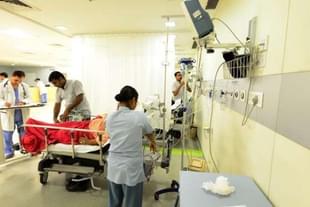Politics
How Data-Driven Ayushman Bharat Will Unlock The Potential Of Personalised Medicine
Urvashi Prasad
Sep 15, 2018, 06:59 AM | Updated 06:59 AM IST
Save & read from anywhere!
Bookmark stories for easy access on any device or the Swarajya app.


In his fifth Independence Day speech, Prime Minister Narendra Modi announced that the Pradhan Mantri Jan Arogya Abhiyaan (Ayushman Bharat) will be formally launched on 25 September 2018. Ayushman Bharat is a highly ambitious effort by the government to move away from the largely fragmented implementation of vertical programmes to deliver health services to the population in a comprehensive manner.
The first pillar of Ayushman Bharat, the health and wellness centres, will deliver comprehensive primary healthcare including universal screening for non-communicable diseases such as diabetes, hypertension and common cancers as well as tuberculosis and leprosy. This will enable diseases to be treated early on thereby averting costly and complicated treatments at later stages. Around 25,000 health and wellness centres have been approved thus far, of which, 5,000 are operational.
The second pillar of Ayushman Bharat will provide approximately 50 crore people (from about 10 crore families identified through the latest socio-economic caste census) with cashless and paperless access to health services up to Rs 5 lakh per family per year at the point of service in both public and private empanelled hospitals across India.
Beneficiaries under the scheme will be able to avail services anywhere in India thereby providing them with financial risk protection from catastrophic health episodes. To ensure that nobody is left out (especially women, children and the elderly) there will be no cap on family size and age under the programme. The benefit cover will also include pre- and post-hospitalisation expenses. In fact, all pre-existing conditions will be covered from day one of the policy. A defined transport allowance per hospitalisation will also be paid to the beneficiary.
Such a scheme is very much the need of the hour especially in the Indian context where the quantum of public finance on health has been consistently low (around 1.15 per cent of GDP). As a consequence, India’s out-of-pocket expenditure is as high as 62 per cent with catastrophic health expenditures contributing to an increase in poverty levels in rural and urban areas by 3.6 per cent and 2.9 per cent respectively. Research has shown that Askeskin, Indonesia’s largest health insurance scheme that covered around 76.4 million people in 2007 had a protective effect on out-of-pocket spending on health. The scheme covered nearly all types of care and had a generous benefits package. India’s Pradhan Mantri Jan Arogya Abhiyaan also proposes to cover most secondary and tertiary care interventions funded in a 60:40 ratio by central and state governments.
A fair amount of preparatory work has been undertaken prior to the launch and rollout of the Pradhan Mantri Jan Arogya Abhiyaan. The National Health Agency has been established, which in coordination with its counterpart at the state and union territory level, will perform several key functions such as setting standards, determining the process for empanelling hospitals, monitoring the quality of services and minimising unnecessary hospitalisation, among others.
Rates for around 1,350 treatment packages that will be covered under the scheme have also been released by the National Health Agency. A rigorous process was followed for determining these rates including examination of the Central Government Health Service and Rashtriya Swasthya Bima Yojana packages as well as those offered by various states. To meet context-specific requirements, states and Union territories will have the flexibility to modify these rates within a limited bandwidth.
Further, pre-authorisation will be mandatory for nearly half of the 1,350 packages covered under the programme to ensure that people who are insured do not go through additional healthcare interventions regardless of their needs. This is an important design element of the programme that leverages lessons learned from the implementation of health insurance schemes like Aarogyasri in Andhra Pradesh under which there were reports of unnecessary hysterectomies being conducted, especially by private hospitals.
Model tender documents and final operational guidelines have also been released along with the launch of a web portal for empanelling hospitals under the programme. At least 7,400 applications have been received by the government thus far for hospital empanelment.
Additionally, a robust IT backbone is being tested prior to the rollout of the scheme across the country. The technology platform will serve as a key enabler for ensuring that the scheme is implemented in a transparent and data-driven manner.
Thus far, 30 states have signed an MoU with the National Health Agency for the implementation of the Pradhan Mantri Jan Arogya Abhiyaan. Undoubtedly, the success of the scheme will depend greatly on the active involvement of states and Union territories in the spirit of cooperative federalism. While the Centre can provide the policy framework along with the necessary support and flexibility for implementation, ultimately, it is the states and Union territories that will need to own the scheme.
The programme not only provides an unprecedented opportunity to address the health needs of 50 crore citizens in a comprehensive manner but also to define the priorities for the health system as well as shape future policies by drawing insights from the large data sets that will be generated. This information can pave the way for the advancement of personalised medicine in the country as well as improve the governance of health facilities by providing crucial data on the quality of care they offer.
Disclaimer: The views expressed are personal.
Director, Development Monitoring and Evaluation Office, NITI Aayog.





